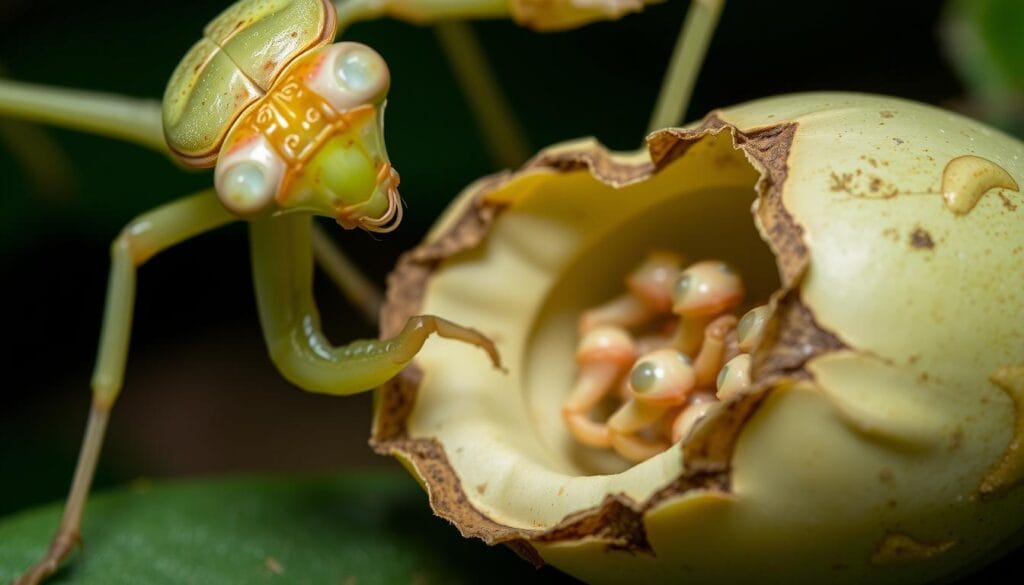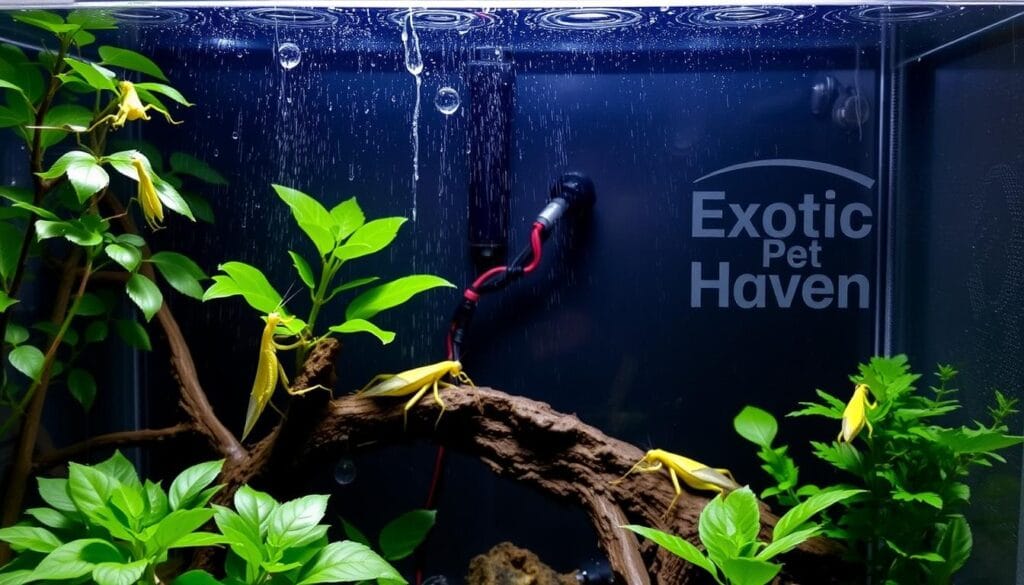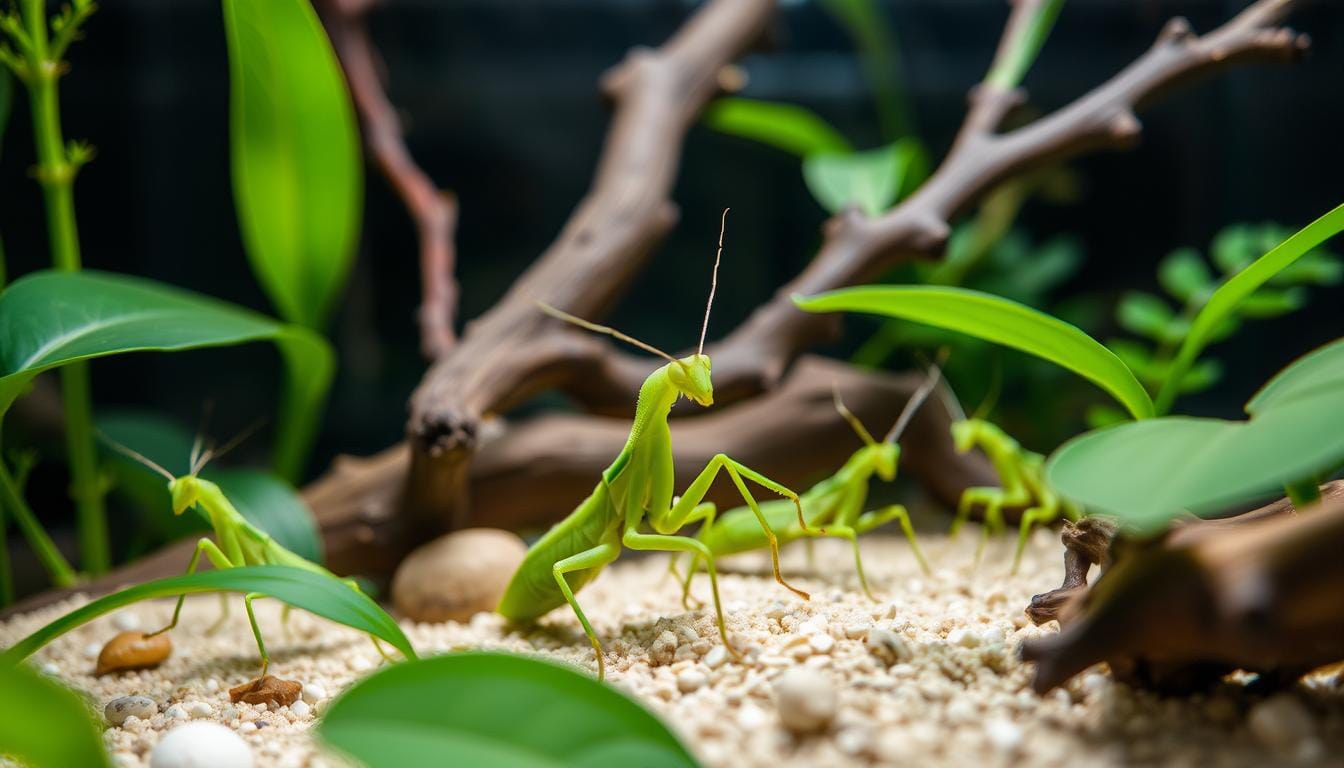Have you ever watched a tiny baby praying mantis emerge from its egg case? It’s a wonder of nature. Breeding these insects is an adventure that connects you with nature’s most fascinating predators. It opens a world of insect reproduction and survival.
Praying mantis breeding is more than a hobby. It’s a way to understand their remarkable reproductive strategies. Some species can reproduce sexually and asexually. Females can even produce offspring without male fertilization. The warmer months of spring and summer are the best times for mantis mating and egg production.
Learning about baby praying mantis care takes patience and observation. It’s a journey that can be rewarding for anyone interested in insects. Whether you’re a hobbyist or an aspiring entomologist, raising these tiny predators is a unique experience.
Table of Contents
Understanding Baby Praying Mantises
Explore the amazing world of praying mantises. These insects are fascinating to both nature lovers and gardeners. They have unique traits that set them apart in the insect world.
What Are Praying Mantises?
Praying mantises are insects known for their praying-like stance and hunting skills. They come in over 2,400 species and live in many tropical areas. They can also live in different environments.
- Possess two compound eyes and three simple eyes
- Feature specialized raptorial legs for capturing prey
- Can have different wing configurations
Lifecycle of a Praying Mantis
The life cycle of a mantis is truly amazing. Female mantises lay eggs in protective cases called oothecae. These cases can hold dozens to hundreds of eggs. The eggs hatch into tiny mantis nymphs after a few weeks or months.
| Lifecycle Stage | Key Characteristics |
|---|---|
| Egg Stage | Protected in ootheca, 1-5 cm long |
| Nymph Stage | Voracious predators, multiple molts |
| Adult Stage | Sexual reproduction, possible cannibalism |
Female mantises can boost egg production by consuming their mates, increasing egg numbers by at least 22%.
Benefits of Raising Mantises at Home
Raising praying mantises at home has many benefits. They help control pests by eating flies, beetles, and other small insects. Their behavior and looks make them interesting pets. They teach us about insect ecosystems.
- Excellent pest control
- Educational pet experience
- Low maintenance
- Fascinating to observe
Setting Up the Perfect Habitat
Creating a great mantis habitat needs careful planning and detail. Your praying mantis will do well in a mantis terrarium that looks like its natural home. Knowing what makes a good mantis enclosure is key to keeping these insects healthy and happy.
Choosing the Right Enclosure
Finding the perfect mantis enclosure is your first step. For most species, a glass or mesh terrarium is best. Look for these important features:
- Size: 5-10 gallon tank recommended
- Material: Transparent glass or well-ventilated mesh
- Height: At least 3 times the mantis length for climbing
- Secure lid with proper ventilation
Temperature and Humidity Essentials
Keeping the right conditions is key for your mantis habitat. Most species need certain environmental settings:
| Parameter | Ideal Range |
|---|---|
| Temperature | 75-85°F (24-29°C) |
| Humidity | 50-70% |
| Lighting | 14-17 hours daily |
Substrate and Habitat Decoration
Your mantis terrarium should have natural elements for comfort and fun. Good substrates include:
- Peat moss
- Coco fiber
- Organic soil mix
“A well-designed habitat is key to a healthy and active praying mantis.” – Entomology Experts
Add climbing structures like branches, twigs, and artificial plants for a rich, naturalistic environment. Make sure there’s good air flow and don’t overcrowd. This keeps your mantis comfortable and stress-free.
Sourcing Praying Mantis Eggs
Finding the right mantis eggs for your collection takes research and knowledge. Praying mantis fans have many ways to get these egg cases, or oothecae. These cases protect the young mantises.
Where to Find Egg Cases
You can find mantis eggs in several places:
- Natural outdoor spots in late spring and early summer
- Online insect stores
- Local pet stores that sell exotic animals
- Companies that sell entomology supplies
Timing for Collecting Eggs
The best time to collect egg cases is from late May to early July. Female praying mantises lay their oothecae on branches and twigs. An ootheca can have 10 to 400 eggs, depending on the mantis species.
Purchasing from Suppliers
When buying mantis eggs, keep these points in mind:
- Make sure the species is native or non-native
- Check the supplier’s reputation
- Ensure the eggs are stored and shipped correctly
- Ask for detailed care instructions
“Not all mantis egg cases are created equal. Research and careful selection are key to successful mantis breeding.” – Entomology Expert
Only about one-fifth of mantis eggs make it to adulthood. Buying from trusted suppliers boosts your chances of raising these interesting insects.
Hatching Baby Praying Mantises
Bringing baby praying mantises into the world is exciting for insect lovers. Knowing how mantis eggs hatch is key for caring for the nymphs.
Preparing the Eggs for Hatching
To get ready for hatching mantis eggs, you need the right setup. The egg case needs certain conditions for the nymphs to grow well:
- Maintain temperatures between 68°F to 77°F
- Keep humidity levels around 60-70%
- Place the egg case in a well-ventilated area
- Avoid direct sunlight or extreme temperatures

Observing the Hatching Process
Watching mantis eggs hatch is amazing. Nymphs usually come out in 3-10 weeks with the right conditions. Look for tiny cracks in the egg case, which means the nymphs are about to come out.
“The moment baby mantises emerge is like witnessing a tiny miracle of nature.” – Entomology Expert
Common Challenges during Hatching
Caring for nymphs during hatching needs close attention. Be ready for common problems:
| Challenge | Solution |
|---|---|
| Cannibalism | Separate nymphs immediately after hatching |
| Low Humidity | Mist egg case lightly with water |
| Limited Food Supply | Provide tiny insects like fruit flies |
Remember, one egg case can have 10 to 400 nymphs. So, be ready for a big group. Hatching mantis eggs well needs patience, watching closely, and good nymph care.
Feeding Baby Praying Mantises
Raising baby praying mantises needs careful attention to their diet. These insects have specific needs that change as they grow. They start as tiny nymphs and become adult predators.
Recommended Diet for Young Mantises
When feeding baby mantis, focus on tiny prey. Young praying mantises eat:
- Fruit flies
- Aphids
- Tiny crickets
- Pinhead-sized insects
Feeding Frequency and Portion Control
Nymphs need to eat every day to grow fast. Make sure prey is no bigger than their eyes. This helps them catch and eat their food.
| Mantis Age | Prey Size | Feeding Frequency |
|---|---|---|
| Newly Hatched | Fruit flies | Daily |
| 2-4 Weeks | Small crickets | Every other day |
| 1-2 Months | Larger crickets | 2-3 times per week |
Common Feeding Mistakes to Avoid
When feeding baby mantis, avoid these mistakes:
- Overfeeding
- Providing prey too large for the mantis
- Using wild-caught insects that might carry pesticides
- Neglecting to remove uneaten prey
“Careful feeding is the cornerstone of successfully raising healthy praying mantises.” – Entomology Expert
Pro tip: Always choose pesticide-free live prey. Buy from reputable sources to keep your mantis healthy and strong.
Maintaining Ideal Conditions
Creating the perfect environment is key for mantis care. Praying mantises are sensitive and need specific environmental conditions to thrive and stay healthy.
Watering and Humidity Management
Keeping the right humidity is vital for your mantis’s survival. Most species need humidity between 50-70%. You can achieve this with careful misting.
- Use a fine mist spray bottle to lightly dampen the enclosure
- Place a small water dish for indirect humidity
- Monitor humidity levels with a hygrometer

Temperature Control Techniques
Temperature is also key in mantis care. Keeping the habitat between 75-85°F is best for their health and activity. Here are some tips:
- Use heat lamps for consistent warmth
- Avoid direct sunlight and drafty areas
- Create temperature gradients within the enclosure
“Consistent environmental conditions are the key to a happy, healthy mantis.” – Entomology Experts
Lighting Requirements
Proper lighting is important for your mantis’s natural rhythms. Aim for 14-17 hours of indirect light daily. Natural light cycles help regulate their biological processes and promote healthy development.
Remember, each mantis species has unique needs. Always research your specific type to provide the best care.
Managing Health and Pests
Keeping your mantis healthy means watching closely and acting fast against pests. Your praying mantis can face health problems that need quick action.
Signs of Health Issues
Spotting health issues early is key to your mantis’s survival. Look out for these important signs:
- Unusual lethargy or reduced movement
- Discoloration of body or legs
- Difficulty molting
- Loss of appetite
- Abnormal posture or trembling
Basic Disease Prevention
To stop diseases, create a great home for your mantis. Follow these steps for mantis health:
- Maintain clean enclosure conditions
- Provide balanced nutritional diet
- Control humidity levels between 50-70%
- Avoid excessive handling
- Prevent overcrowding
Dealing with Common Pests
It’s vital to keep pests away from your mantis. Some pests to watch out for are:
| Pest Type | Treatment Method | Prevention Strategy |
|---|---|---|
| Mites | Gentle bathing | Regular enclosure cleaning |
| Fungal Infections | Isolate affected mantis | Control humidity levels |
| Parasitic Organisms | Veterinary consultation | Maintain sterile environment |
Remember, quick action and careful observation are your best tools in maintaining your praying mantis’s health and preventing pest-related issues.
If your mantis has serious health problems, see an exotic pet vet. They should know about invertebrates.
Preparing for Growth and Maturity
Knowing about mantis growth stages is key to raising these insects well. Your praying mantis will go through many changes before becoming an adult. Each stage needs special care to help them grow and develop well. You can learn more about mantis growth and development.
When mantises are breeding and growing, it’s important to keep them calm. Don’t handle them too much and keep their environment steady. Also, make sure they have places to climb.
Mantises are very delicate during their molting. This is when they shed their skin to grow. They are very sensitive during this time. So, make sure their environment is quiet and stable.
As mantises get ready to breed, it’s a good idea to keep them apart. This helps prevent them from eating each other. Different mantis species have their own ways of breeding. Some can even make babies without a male. Adult mantises live 6-12 months, with females often living longer than males. Knowing about their growth helps you raise healthy mantis colonies.


You should take part in a contest for one of the finest
sites on the web. I most certainly will recommend this site!